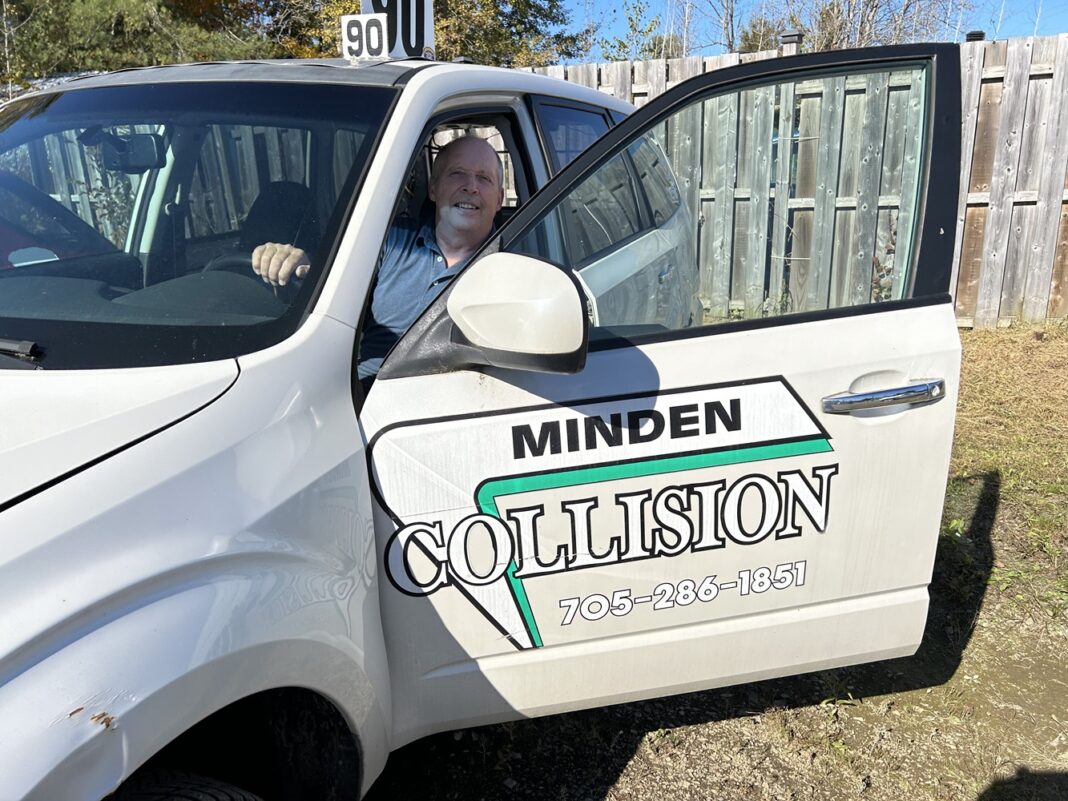Hitting a long stretch of ice while behind the wheel would be a rare white-knuckle experience for most drivers, but for Minden’s Jim Carrell that’s a regular Saturday come wintertime.
The recently-retired Kinsmen is one of the many faces behind the Minden Ice Races. Each year, volunteers transform the fairgrounds into a winding, frozen-over circuit that draws people from across North America. It’s one of the few “dry land” locations in the country, and the home of ice racing in Ontario.
With winter right around the corner, Carrell said excitement is starting to set in as he prepares for a 35th season of racing in the community. He said the Minden Kin Club has been building and maintaining the track for as long as racing has been coming to Minden.
“It’s the Canadian Automobile Sport Clubs (CASC) ice racing competition for Ontario region. They used to go community to community, but now Minden is the sole home. We have racing here for six weekends,” Carrell said, noting it’s been that way since the 1970s.
“Because of the costs involved and the effort it takes to get the track set up, it wouldn’t make sense for us to do this and have it be a one and done… it’s a great draw, we get people from as far away as Thunder Bay. Aside from snowmobiling, it’s probably one of the things people come to the County most for during winter,” he added.
Carrell, who owned and operated Minden Collision for decades before passing the business to his son, Jeff, this summer, has dabbled in racing for 30-plus years. He’s been racing in Minden for the past 20.
The adrenaline rush while sitting behind his wheel, waiting for the flag to drop, is unlike anything he’s experienced before.
“I’m smiling just thinking about it – I can’t wait to get back out there. Flying down the straight, heading into a turn, looking to your side and seeing one of your buddy’s right there with you, almost door-to-door, I can’t explain it. It’s so much fun,” Carrell said.
His chosen four-wheeled chariot is a 2009 Subaru Forester. The car cost him $500, a write-off for usual purposes, but perfect for ice racing. He estimates investing about $1,000 to get it race-ready, spending another $700 on a set of studded tires. All in, for $2,500, he gets months of excitement and entertainment.
“It doesn’t have to be an expensive hobby by any means – I’m five years in with this car now and running it yearto-year, it’s not a lot of money at all,” he said. “I’ve got to make sure the brakes are good, that the seatbelt is in working order, replace the oil – but aside from that, it’s good to go.”
Races are split into different classes depending on car specification – four-wheel, front-wheel, or rear-wheel drive – and type of tire, either street studs or standard winter rubbers. There are options to ride alone, or with a passenger – where you race as a pair and alternate the lead.
While it used to be the wild west in terms of what was allowed, there has been some new regulations recently. Because of the shorter winters and unpredictably warmer weather at times, CASC introduced limits on the types of studded tires that can be used. It’s important now, when the Kin Club gets the track in racing shape, that it not get ripped up every weekend by longer spikes, Carrell said.
“Last year we only got four weekends in, and that was with the new regulations,” he said.
The races attract about 60 drivers for a six weekend season, usually beginning in January. Carrell said the best resource for anyone wanting to get involved is the CASC website, where all the rules are posted as well as helpful tips and tricks.
When selecting a car, Carrell said make sure it’s not completely rusted underneath – due to the slippery nature of ice racing, collisions are frequent. “We don’t want cars falling apart because that’s when people get hurt.”
Most of the interior can be stripped away, save for the driver seat and seatbelt. Airbags must be taken out, Carrell said. Exterior lights on the front must come off too, while bumpers must be properly secured, and a rear-facing light installed so other drivers know where you are.
“That’s important, especially in the studded-tire class. Those cars throw snow in the air like nobody’s business. It’s like being in the worst blizzard you’ve ever seen,” Carrell said.
He’s been competitive on the circuit, winning a championship recently, but for Carrell ice racing is all about camaraderie and community.
“It’s like having a whole other family. I’ve made some lifelong friendships through racing. Everyone is competing for the checkered flag at the end, but there’s a lot of laughs away from the track when the race is over,” Carrell said.
For more information, visit casc.on.ca.





